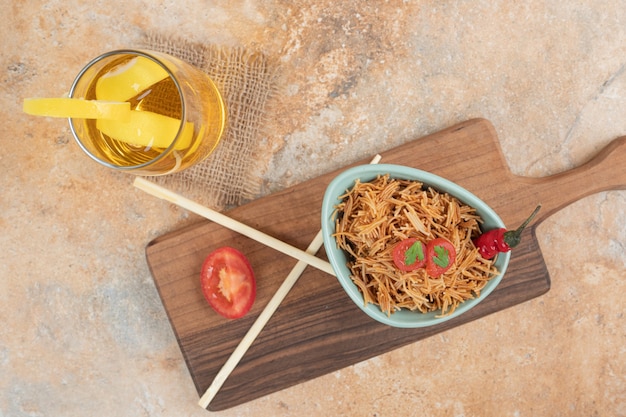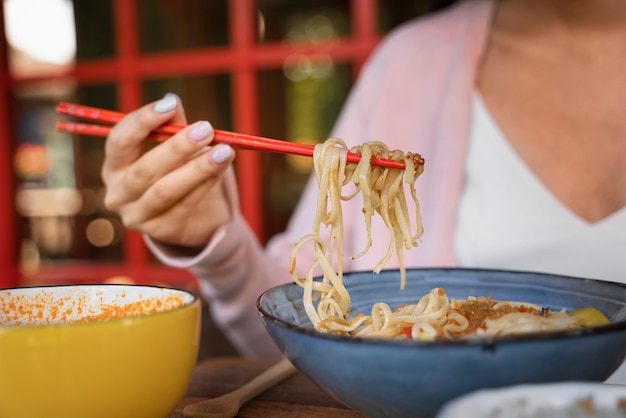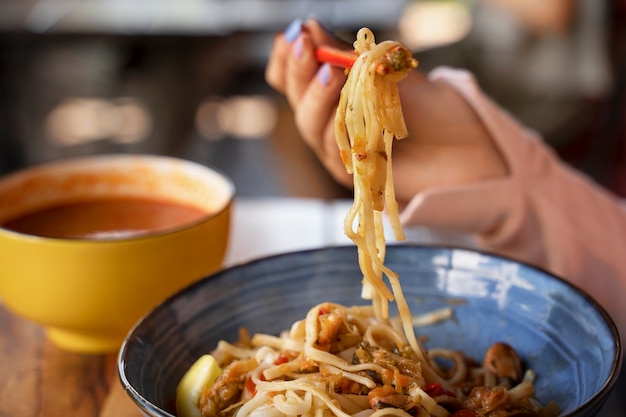You know that feeling? The one where you're craving a takeaway but the thought of ordering in for the umpteenth time this week just feels a bit... well, uninspired. You're yearning for a hearty, satisfying meal, something that's both comforting and bursting with flavour. Maybe it's that image of a steaming bowl of lo mein – those delicious, stir-fried noodles, brimming with colourful vegetables and your favourite protein.
Well, I'm here to tell you, making a restaurant-quality lo mein at home is surprisingly simple! You don't need fancy culinary skills to create a dish that's authentic and truly delicious. In fact, as a self-proclaimed culinary novice, I can vouch for the ease and joy of whipping up a lo mein masterpiece right in my own kitchen.
Let me take you on a culinary journey, step-by-step, through my foolproof lo mein recipe. I'll share my tried-and-true tips and tricks, so you can create a dish that's bursting with flavour and texture. And trust me, when you taste this homemade lo mein, you'll be saying, "I can't believe I made this!"
(Part 1) Setting the Stage

Before we dive into the details, let's imagine the scene. It's a chilly evening, rain is drumming against the windowpanes, and you're craving something warm and comforting. A big pot is bubbling merrily on the stove, the aroma of ginger and garlic filling the air, promising a delicious, homemade meal to come. Sounds pretty perfect, right?
I won't lie – lo mein does require a bit of time and effort. But trust me, it's worth every minute. The reward? A bowl of restaurant-worthy goodness that will leave your taste buds singing with joy.
The Essential Equipment: Your Culinary Toolkit
Let's start with the essentials – the equipment you'll need to get started. Here's a quick rundown:
- Large Wok: This is the star of the show when it comes to stir-frying, but if you don't have one, a large frying pan will do the trick. The key is to have enough space for everything to cook evenly.
- Wooden Spatula: Essential for tossing the noodles and veggies with ease. It's gentle on your pan and helps to prevent sticking.
- Cutting Board: You'll need a sturdy cutting board for chopping up your veggies.
- Sharp Chef's Knife: A must-have for chopping and slicing your veggies into bite-sized pieces.
- Measuring Cups and Spoons: These will help you achieve the perfect balance of flavours by ensuring precise ingredient measurements.
- Small Bowl: For mixing your sauce. This will ensure the sauce is perfectly combined before it's poured over your lo mein.
- Colander: Used to drain the noodles after they're cooked, ensuring they're ready for the stir-fry.
See? It's not as complicated as you might think! A few essential tools are all you need to create a lo mein masterpiece.
(Part 2) The Star of the Show: Noodles

Now, let's talk about the star of the show – the noodles! This is where you'll find a lot of variety, and it really depends on your personal preference.
Choosing Your Noodle Stars: A culinary adventure
Here's a breakdown of the most common types of noodles you'll find, each with its own unique character:
- Egg Noodles: These are the classic choice for lo mein, offering a slightly chewy texture and a subtle egg flavour. You'll find them readily available in most supermarkets.
- Wheat Noodles: A great alternative if you're seeking a more neutral flavour. They're also commonly used in other Asian stir-fry dishes.
- Ramen Noodles: Often used in Japanese-style lo mein, ramen noodles offer a slightly thicker texture and a more robust flavour.
- rice noodles: If you're looking for a lighter option, rice noodles are a fantastic choice. They're also gluten-free.
Personally, I'm a sucker for good old-fashioned egg noodles. They're a classic for a reason! I find they soak up the sauce beautifully, resulting in a truly satisfying meal. But feel free to experiment with other types – you might discover a new favourite!
Prepping Your Noodles: Getting Ready for the Stir-Fry
Once you've chosen your noodles, it's time to prep them. You'll need a large pot filled with boiling water.
- Boil the Noodles: Add your noodles to the boiling water and cook for about 3-4 minutes, or until they're slightly tender but still have a bit of bite. Remember, you'll be stir-frying them later, so they don't need to be fully cooked.
- Drain the Noodles: Once the noodles are cooked, drain them in a colander and rinse them with cold water. This stops the cooking process and prevents them from sticking together.
And there you have it! Your noodles are ready to be transformed into a delicious lo mein masterpiece.
(Part 3) The Veggie Powerhouse: A Burst of Colour and Crunch

Now, let's talk about the veggies! This is where you can really add a burst of flavour and vibrant colour to your lo mein.
Choosing Your Veggie Stars: The Flavorful Cast
There are no strict rules here – it's all about what you enjoy! However, some classic lo mein veggies that are sure to please include:
- Cabbage: It adds a delightful crunch and a touch of sweetness. I often use a mix of green and red cabbage for extra visual appeal and a bit of added complexity.
- Carrots: A great source of vitamin A, carrots contribute a lovely sweetness to the dish.
- Mushrooms: Whether it's shiitake, oyster, or button mushrooms, they bring a wonderful earthy flavour and a bit of texture.
- Bean Sprouts: These add a lovely crispness and a slightly nutty flavour. They're also a nutritional powerhouse.
- Celery: It brings a refreshing bite and adds a nice visual contrast to the other veggies.
- Onions: I use both green onions and red onions for their distinct flavours and textures. Green onions add a milder flavour and are often used as a garnish. Red onions, with their sharper taste, add a nice complexity.
Prepping Your Veggies: Getting Ready for the Stir-Fry
Here's how to get your veggies ready for the stir-fry:
- Chop: Chop your veggies into bite-sized pieces so they cook evenly. If you're using cabbage, you might want to shred it thinly for a softer texture.
- Set Aside: Once your veggies are chopped, set them aside until you're ready to stir-fry them.
Now your veggies are ready to add that satisfying crunch and flavour to your lo mein!
(Part 4) The Protein Punch: Adding Substance and Flavour
So, you've got your noodles and your veggies, but what about the protein? This is where you can get creative and add your own personal touch.
Choosing Your Protein: A Symphony of Flavours
Here are some popular protein choices that complement lo mein beautifully:
- Chicken: It's a classic choice for lo mein, adding a light and flavourful protein boost. I usually slice it thinly so it cooks quickly and evenly.
- Shrimp: For a more seafood-inspired lo mein, shrimp is a fantastic option. It cooks quickly and absorbs the sauce beautifully.
- Tofu: For a vegetarian option, tofu is a great choice. It's packed with protein and soaks up the flavours of the sauce beautifully.
- Pork: If you're looking for a richer and more robust flavour, pork is a delicious option.
- Beef: Another hearty choice, beef adds a bold flavour and a satisfying texture to the lo mein.
Prepping Your Protein: Getting Ready for the Stir-Fry
The way you prep your protein will depend on your choice. For example,
- Chicken: Slice it thinly and marinate it in a mixture of soy sauce, ginger, garlic, and sesame oil for about 30 minutes. This adds extra flavour and tenderness.
- Shrimp: Peel and devein the shrimp. Then, toss them in a mixture of cornstarch and salt. This helps them to cook evenly and prevents them from sticking to the pan.
- Tofu: Drain and press the tofu to remove excess moisture. Then, cut it into cubes. You can also marinate it in your favourite sauce for extra flavour.
- Pork: Slice it thinly and marinate it in a mixture of soy sauce, ginger, garlic, and rice wine.
- Beef: Slice it thinly against the grain and marinate it in a mixture of soy sauce, oyster sauce, and sesame oil.
Your protein is now ready to join the party!
(Part 5) The Secret Sauce: Bringing it all Together
Alright, so you've got your noodles, your veggies, and your protein – now it's time to bring everything together with a delicious, flavour-packed sauce. This is where you can really add your personal touch and create a lo mein that's uniquely your own.
The Basic Lo Mein Sauce: A Foundation for Flavour
Here's a basic lo mein sauce recipe that you can use as a starting point:
- Soy Sauce: The foundation of the sauce, adding a salty and umami flavour.
- Oyster Sauce: Provides a rich, savory flavour with a slight sweetness.
- Sesame Oil: Adds a nutty and fragrant aroma.
- Sugar: Balances the saltiness of the sauce with a touch of sweetness.
- Cornstarch: Thicken the sauce and creates a glossy finish.
- Ginger and Garlic: Adds a punch of flavour and aroma.
This basic sauce recipe provides a great foundation for creating your own unique flavour combinations.
Variations for a Unique Flavour: Explore Your Creativity
To make your sauce even more exciting, here are a few variations you can try:
- Spicy Lo Mein: Add a pinch of chili flakes or a dash of sriracha to the sauce. For a bolder flavour, you can even use a bit of freshly chopped chilies.
- Sweet and Sour Lo Mein: Add a tablespoon of vinegar and a teaspoon of honey to the sauce. This variation adds a tangy, sweet flavour that is both refreshing and delicious.
- Teriyaki Lo Mein: Substitute the oyster sauce with teriyaki sauce and add a teaspoon of sake or mirin. This gives you a more pronounced sweet-savoury flavour profile.
- Peanut Lo Mein: Add a tablespoon of peanut butter to the sauce and a sprinkle of chopped peanuts for garnish. This variation adds a creamy and nutty element to the dish.
Remember, the beauty of cooking is experimentation! Play around with different ingredients and discover your favourite lo mein sauce combination.
(Part 6) The Magic of Stir-Frying: A Culinary Symphony
Finally, we're ready for the grand finale: the stir-fry! This is where everything comes together, and where you can really unleash your inner chef.
A Few Tips for Stir-Frying Success: Mastering the Technique
Here are a few tips to ensure you get the perfect stir-fry:
- Hot Pan: Use a high heat and ensure your wok or pan is piping hot before you start stir-frying. This will help to cook the ingredients quickly and evenly.
- Don't Overcrowd: Avoid adding too many ingredients to the pan at once. This will prevent the food from cooking properly and will make the pan too crowded. Work in batches if necessary.
- Toss and Move: Keep tossing and moving the ingredients in the pan to ensure they cook evenly. This constant movement ensures everything cooks quickly and doesn't burn.
- Short cooking time: Stir-frying is all about speed. Cook the ingredients quickly and don't overcook them. The goal is to retain the freshness and crispness of the ingredients.
Remember, a good stir-fry is a delicate dance of heat, speed, and movement. Mastering the technique takes practice, but the results are truly rewarding!
The Stir-Fry Steps: Bringing Your Lo Mein to Life
Here's how to stir-fry your lo mein:
- Heat the Pan: Heat your wok or pan over high heat. Add a tablespoon of oil and swirl it around the pan to coat the bottom.
- Stir-Fry the Protein: Add your protein to the hot pan and stir-fry it until it's cooked through. Don't overcrowd the pan – work in batches if necessary.
- Stir-Fry the Veggies: Add the veggies to the pan and stir-fry them for about 2-3 minutes, or until they're tender-crisp.
- Add the Noodles: Toss in the noodles and stir-fry everything together for another minute or so. The noodles will absorb the flavours of the protein and veggies.
- Pour in the Sauce: Pour the sauce over the noodles, veggies, and protein. Stir-fry everything together until the sauce is heated through and coats the ingredients evenly.
- Serve and Enjoy: Serve immediately and enjoy! The lo mein is best enjoyed fresh, so don't wait to dig in!
Your homemade lo mein is now ready to be devoured. Enjoy the symphony of flavours!
(Part 7) Finishing Touches: A Burst of Freshness
Now, your lo mein is pretty much ready to go, but for an extra burst of flavour and freshness, you can add some finishing touches.
Garnishings for an Extra Zing: Elevating Your Lo Mein
Here are a few options to take your lo mein to the next level:
- Chopped Green Onions: Adds a fresh, bright flavour and a lovely green colour.
- Sesame Seeds: Toasted sesame seeds add a nutty flavour and a pleasing crunch.
- Fresh Coriander: For a fragrant and herbal touch.
- Chili Flakes: For a bit of heat and a spicy kick.
- Lime or Lemon Wedges: A squeeze of fresh citrus juice adds a bright acidity to the dish.
Feel free to get creative and experiment with your own favourite garnishes!
(Part 8) Lo Mein: A Culinary Journey
Making lo mein is a journey, a culinary adventure that allows you to explore different flavours and textures. It's a dish that's versatile, allowing you to customize it to your taste.
So, next time you're craving a takeaway, remember that you can easily recreate that restaurant-style goodness in your own kitchen. It's a delicious, satisfying, and surprisingly easy dish that's sure to become a family favourite.
FAQs
Here are some frequently asked questions about lo mein:
1. Can I make lo mein ahead of time?
Yes, you can absolutely make lo mein ahead of time. However, it's best to avoid stir-frying the noodles until you're ready to serve them. This will help to prevent them from becoming soggy. You can cook the noodles, veggies, and protein ahead of time and keep them separate in the fridge. When you're ready to eat, simply heat everything up in a wok or pan and toss in the sauce.
2. What if I don't have a wok?
Don't worry, you can still make a delicious lo mein without a wok. A large frying pan will work just fine. Just make sure it's big enough to accommodate all the ingredients. You may need to stir-fry the ingredients in batches to prevent overcrowding.
3. Can I use pre-made lo mein sauce?
Absolutely! You can find pre-made lo mein sauce at most Asian grocery stores or online. Just be sure to check the ingredients list to make sure it's something you like. You can also experiment by adding your own flavour twists to a pre-made sauce.
4. What can I do with leftover lo mein?
Leftover lo mein is a great for a quick and easy lunch or dinner. You can reheat it in a microwave or a pan. You can also add it to a salad for a bit of extra flavour and texture.
5. Can I freeze lo mein?
While you can freeze lo mein, it's not ideal. The noodles tend to become soggy when thawed. It's best to enjoy your lo mein fresh. If you do need to freeze it, consider freezing the noodles and sauce separately and reheating them together later.
Everyone is watching

Corn on the Cob: The Ultimate Guide to Perfectly Cooked Ears
Healthy MealsAh, corn on the cob. Just the name evokes images of sunny days, barbecues, and that sweet, juicy flavour that ...

Perfect Pork Roast Oven Cooking Time: A Guide to Delicious Results
Healthy MealsThere's something truly satisfying about a perfectly roasted pork. The aroma alone is enough to make your mout...

Ham Cooking Time: How Long to Bake, Smoke, or Boil a Delicious Ham
Healthy MealsAh, ham. It's a classic, isn't it? A real crowd-pleaser, especially around holidays. And when done right, it'...

Scallops: The Ultimate Guide to Perfect Cooking
Healthy MealsAh, scallops. Those delicate, sweet, and utterly delicious morsels of the sea. They hold a special place in my...

Spaghetti Squash: The Ultimate Guide to Cooking and Serving
Healthy MealsRemember that time you saw spaghetti squash at the supermarket, looking all bumpy and strange, and thought, "W...
